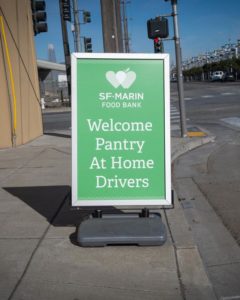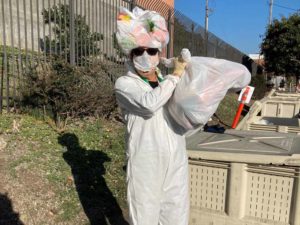 In September the Food Bank approached several regular Pantry at Home volunteers with an idea: adopt a building; commit to making all your deliveries to the same location and the same participants at the same time week after week for three months.
In September the Food Bank approached several regular Pantry at Home volunteers with an idea: adopt a building; commit to making all your deliveries to the same location and the same participants at the same time week after week for three months.
A few regular volunteers were all in.
Kelly Runyon and his wife Barbara decided to adopt a building as a way to show their love for a neighborhood they enjoyed visiting.
“I filled out an application and said I’d be interested in Chinatown,” said Kelly, who spent the next three months delivering to 44 participants every Monday and Tuesday.
Patricia Tuori, who had been volunteering twice a month for weeks, though it would be a great way to keep volunteering even after her work schedule changed. After adopting a building, Patricia always knew her Tuesday route would take about an hour and a half door to door.
She explained, “I was working while I was doing this, so, it was nice to take a little bit less time at it. But I still got to do it.”
A Whole New Experience
Both Kelly and Patricia felt that adopting a building (or in their cases a few buildings) enriched the Pantry at Home experience for both themselves and the participants.
Kelly and Barbara have lived in San Francisco since the seventies. Despite decades in the City, they still “went to a lot of neighborhoods that we had no idea even existed. So, it was interesting for that reason. We kind of got to know the city better.”
But the real joy came in adopting a few buildings. “We got to know individuals and they got to know us,” he said. “They knew when I knocked on the door, they knew my knock.”
They also discovered suppressing benefits on a pragmatic front. Coming back week after week helped them learn the ins and outs of each building. One apartment required a key fob to use the elevator – meeting the building manager and getting her cell phone number was their ticket in.
“Each week we could just text her as we were getting parked and then pick up a fob and do our thing,” explained Kelly. Delivering to that building “went from being an absolute, impenetrable ‘how do we do this’ problem to a whole procedure that was straightforward and always worked.”
Getting to Know the Neighbors
 For Patricia, the greatest reward was getting to know people. “Rather than just going up to a house and you don’t ever see them again, you see the same people every week. It’s a really nice way to develop a relationship,” she said.
For Patricia, the greatest reward was getting to know people. “Rather than just going up to a house and you don’t ever see them again, you see the same people every week. It’s a really nice way to develop a relationship,” she said.
“When I was doing the same two buildings every week, I knew that the neighbor for this person takes both their bags,” she shared. “Or that the person in 202 would leave their door open and they want you to put the bag right inside on the stool.”
The support that came from getting to know each other went both ways. One woman saved all the jars she struggled to open during the week for Patricia to help her open them. Another participant checked in to make sure Patricia was okay after she took a couple of weeks off to quarantine.
“The benefit to [the participant] is just knowing that every Tuesday at 12:30, which is when I did it, there’d be a delivery and they didn’t have to hang around all afternoon or wonder when someone was coming,” said Patricia.
Adopting a building was “just a really nice way to develop a relationship. I don’t know why more people wouldn’t want to do it that way if they could,” she said. “It takes a lot of the unknowns out of it.”


Share